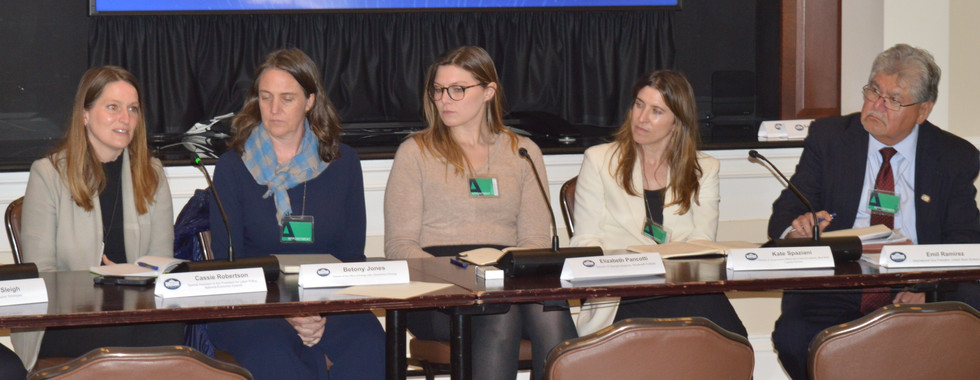Accelerating Labor Investment and Participation in the Clean Energy Transition: Reflections from White House National Economic Council Convening on Catalyzing Strategic Sector Investment.
- heartland21
- May 9, 2024
- 6 min read
Updated: May 13, 2024
On April 22, 2024, The White House National Economic Council (NEC), in partnership with Heartland Capital Strategies, hosted a series of discussions on aligning private sector resources and the Biden-Harris Administration’s investments in clean energy, infrastructure, and manufacturing to accelerate the energy transition and promote economic development. The convening brought together leaders interested in the potential to support high-road labor practices in the clean energy transition. Following “Chatham House Rules,” this report provides reflections on the day, and references statements by participants without attribution (to promote a free discussion).
Attendees included senior Biden-Harris Administration officials from the White House National Economic Council, Department of the Treasury, Department of Commerce, and Department of Energy, as well as Heartland Capital Network members and friends including pension consultants, asset managers, union leaders, think tank representatives and other experts.
The goal of this convening was to discuss approaches to supporting investment in strategic sectors such as clean energy with a focus on high-road labor practices. To help achieve this goal, the convening set out to: (i) define the top priorities of key stakeholders; (ii) identify principal obstacles to capital mobilization and potential solutions; (iii) make connections among involved parties; and (iv) leave participants with new relationships for deal making and pipeline development.
“The U.S. economy requires stable long term investment capital to support growing infrastructure needs. And, the long-term time horizons of pension plans, endowments, and other long-term investors are well aligned with the investment attributes of the infrastructure asset class.”
Steve McCourt, Meketa
There is documentation of the large, anticipated impact of the Inflation Reduction Act (IRA) and Bipartisan Infrastructure Law in promoting clean energy investment. An estimated $370 billion in total energy funding and incentives are authorized in the laws.
The scale of investment requires coordination and ongoing discussion. To achieve President Biden’s goal of halving 2005 greenhouse gas emissions by 2030, Princeton University’s Net Zero America project estimated that annual public and private investments of $200 billion increasing to $300 billion by 2030 will be needed. Actual clean energy investments increased by roughly 50% between 2022 and 2023, but additional investment is needed to meet the Princeton target. The incentives provided by the IRA and the other legislation are just starting to be deployed, so further growth in clean energy investment is anticipated, but the scale of the challenge is clear.
Participants agreed that labor has a potentially large role to play in the clean energy transition. Taft-Hartley pension plans (plans sponsored directly by unions) hold over $700 billion in assets. Public pension plans, many of which serve union members and include union representatives on their boards, hold over $8 trillion in assets. In addition, organized labor can play a large role in worker training and can help provide political support for needed clean energy projects.
Pension investment in clean energy projects to date has been minimal according to participants in the convening. However, the potential for investment is great. Particularly if plans increase their asset allocations to clean energy infrastructure and steer other allocations, such as real estate, to projects that incorporate clean energy features.
Current plan allocations to infrastructure were variously estimated at between 2% and 5%. In contrast, pensions in other countries are much more committed to infrastructure. Australian superannuation plans average an over 8% allocation to infrastructure and Canadian plans average over 10% with some individual plans reaching as high as 30% allocations.
Several participants described infrastructure as a highly advantageous asset class for US pensions. It has many of the investment characteristics of real estate; including contract-based revenues and inflation protection, but without the volatility that the real estate asset class has experienced in recent years. Also, the long-term nature of infrastructure investments fits well with the long-term liabilities of pension plans.
Several participants highlighted the need for pension trustee education. Pension trustees are slow to make changes in policy. Trustee education must focus on: (i) the performance track record of the infrastructure asset class; (ii) the availability of massive government incentives for private investment in clean energy which increases investment returns and reduces investment risks; and (iii) for some projects, the potential role of the Loan Programs Office in underwriting and de-risking projects receiving Loan Programs Office financing.
A participant highlighted the need to address trustee concerns about near-term illiquidity and higher fees typically associated with private investment in infrastructure.
One participant noted that labor-sponsored pensions face a basic challenge in seeking to increase their allocations to infrastructure: The current scarcity of managed infrastructure funds that mandate responsible contractor policies and other project development labor standards considered essential by labor pensions. Several major asset managers were represented at the convening as well.
Another participant noted that, in contrast to labor standards for project development which are well understood based on decades of experience in labor investment in real estate development, there is less consensus among union pensions regarding labor standards for permanent jobs. This is relevant for the operation of clean energy projects and for advanced manufacturing incentivized by IRA and the CHIPS & Science Act.
A participant suggested that it would be helpful to increase the share of US retirement assets held in defined benefit as opposed to defined contribution plans. The participant argued that increasing investment in long-term assets like infrastructure required that more US private assets be held by long-term investors like pensions. US defined contribution investors are generally considered to have a shorter-term outlook. (Interestingly, Australian superannuation plans are DC plans and have relatively high allocations to infrastructure. However, their structures differ markedly from US 401k and similar DC plans.)
Several participants identified capital scarcity at the inception of large projects as restricting the flow of projects into project pipelines. Tax credits typically become available at project completion or at the commencement of production, depending on the nature of the credit. Developers must self-finance or find third-party sources of financing in order to pay project expenses until those milestones are reached. Bridge financing is one response. Another is an active market in transferable tax credits in which tax equity investors are willing to purchase tax credits at a discount and wait until they can be claimed.
Capital for pre-development expenses – that is for project expenses incurred prior to construction loan closing – is particularly scarce because this type of capital is seen as very high risk. Developers must typically look to their own balance sheets for most pre-development capital. There was discussion that it could serve the public interest for the government to play a risk-sharing role with regard to pre-development capital in order to jump-start project pipelines. If projects are not entering pipelines in the first place, the availability of capital for later project stages becomes less relevant to achieving decarbonization goals.
There was discussion about the importance of increasing the liquidity of tax credits through such mechanisms as transferability, direct pay, and elective pay. Treasury regulations prescribing detailed guidelines for these liquidity mechanisms have recently been issued and markets are actively developing.
The need for streamlining project permitting was raised and briefly discussed.
Capacity issues were another theme in the discussion. The Biden infrastructure legislation and the push for a rapid clean energy transition are placing strains on communities and local governments which must find ways to accommodate new projects, and which are actively involved in project permitting. In addition, local governments often find themselves as participants in public-private partnerships to advance key projects. All this imposes demands for resources and expertise that communities and local governments are frequently not prepared for. One participant noted that this is an important hurdle for projects in the Appalachia area – the primary geographic focus for Heartland.
A set of participants had a working discussion on the importance of investing in and revitalizing economically distressed areas. Multiple agencies, including the Department of Energy, the Small Business Administration, and the Economic Development Administration are working to implement policies that are now reaching almost every county in the United States. These include policies related to investment, workforce training, workforce availability, and technical support. In some cases, agency resources are stacking in places that have been left behind. There were specific discussions of opportunities to aggregate difficult-to-finance, small (under $10 million) projects. Also, a participant highlighted the need of small developers for affordable working capital as well as project capital. “Place-based” policies are a priority for the Biden Administration to ensure there is inclusive economic growth. Participants noted that this work requires active collaboration between federal and non-federal actors to improve economic outcomes.
The convening concluded with a networking session among participants to follow-up on ideas brought up in the panel discussions and to seek opportunities to partner to advance clean energy projects and opportunities for unions to play a larger role in the clean energy transition.































Comments